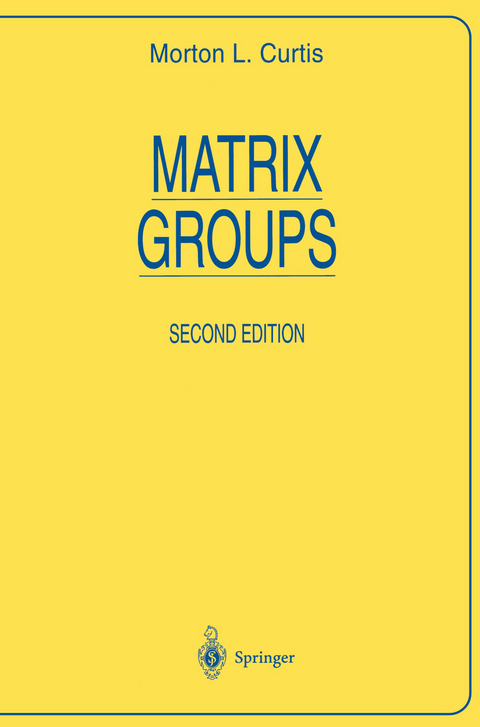
Matrix Groups
Springer-Verlag New York Inc.
978-0-387-96074-6 (ISBN)
These notes were developed from a course taught at Rice Univ- sity in the spring of 1976 and again at the University of Hawaii in the spring of 1977. It is assumed that the students know some linear algebra and a little about differentiation of vector-valued functions. The idea is to introduce students to some of the concepts of Lie group theory-- all done at the concrete level of matrix groups. As much as we could, we motivated developments as a means of deciding when two matrix groups (with different definitions) are isomorphic. In Chapter I "group" is defined and examples are given; ho- morphism and isomorphism are defined. For a field k denotes the algebra of n x n matrices over k We recall that A E Mn(k) has an inverse if and only if det A ~ 0 , and define the general linear group GL(n,k) We construct the skew-field lli of to operate linearly on llin quaternions and note that for A E Mn(lli) we must operate on the right (since we mUltiply a vector by a scalar n on the left). So we use row vectors for R , en, llin and write xA for the row vector obtained by matrix multiplication. We get a ~omplex-valued determinant function on Mn (11) such that det A ~ 0 guarantees that A has an inverse.
1 General Linear Groups.- A. Groups.- B. Fields, Quaternions.- C. Vectors and Matrices.- D. General Linear Groups.- E. Exercises.- 2 Orthogonal Groups.- A. Inner Products.- B. Orthogonal Groups.- C. The Isomorphism Question.- D. Reflections in ?n.- E. Exercises.- 3 Homomorphisms.- A. Curves in a Vector Space.- B. Smooth Homomorphisms.- C. Exercises.- 4 Exponential and Logarithm.- A. Exponential of a Matrix.- B. Logarithm.- C. One-parameter Subgroups.- D. Lie Algebras.- E. Exercises.- 5 SO(3) and Sp(1).- A. The Homomorphism ?: S3?SO(3).- B. Centers.- C. Quotient Groups.- D. Exercises.- 6 Topology.- A. Introduction.- B. Continuity of Functions, Open Sets, Closed Sets.- C. Connected Sets, Compact Sets.- D. Subspace Topology, Countable Bases.- E. Manifolds.- F. Exercises.- 7 Maximal Tori.- A. Cartesian Products of Groups.- B. Maximal Tori in Groups.- C. Centers Again.- D. Exercises.- 8 Covering by Maximal Tori.- A. General Remarks.- B. (+) for U(n) and SU(n).- C. (+) for SO(n).- D. (+) for Sp(n).- E. Reflections in ?n (again).- F. Exercises.- 9 Conjugacy of Maximal Tori.- A. Monogenic Groups.- B. Conjugacy of Maximal Tori.- C. The Isomorphism Question Again.- D. Simple Groups, Simply-Connected Groups.- E. Exercises.- 10 Spin(k).- A. Clifford Algebras.- B. Pin(k) and Spin(k).- C. The Isomorphisms.- D. Exercises.- 11 Normalizers, Weyl Groups.- A. Normalizers.- B. Weyl Groups.- C. Spin(2n+1) and Sp(n).- D. SO(n) Splits.- E. Exercises.- 12 Lie Groups.- A. Differentiable Manifolds.- B. Tangent Vectors, Vector Fields.- C. Lie Groups.- D. Connected Groups.- E. Abelian Groups.- 13.- A. Maximal Tori.- B. The Anatomy of a Reflection.- C. The Adjoint Representation.- D. Sample Computation of Roots.- Appendix 1.- Appendix 2.- References.- Supplementary Index (for Chapter 13).
| Reihe/Serie | Universitext |
|---|---|
| Zusatzinfo | XIV, 228 p. |
| Verlagsort | New York, NY |
| Sprache | englisch |
| Maße | 155 x 235 mm |
| Themenwelt | Mathematik / Informatik ► Mathematik ► Algebra |
| ISBN-10 | 0-387-96074-0 / 0387960740 |
| ISBN-13 | 978-0-387-96074-6 / 9780387960746 |
| Zustand | Neuware |
| Haben Sie eine Frage zum Produkt? |
aus dem Bereich


